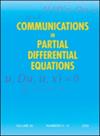初始数据随机分布的Yang-Mills热流
IF 1.7
2区 数学
Q1 MATHEMATICS
Communications in Partial Differential Equations
Pub Date : 2021-11-20
DOI:10.1080/03605302.2023.2169937
引用次数: 6
摘要
摘要我们构造了一类随机分布初始数据的Yang-Mills热流(在DeTurck规范中)的局部解,其中包括三维高斯自由场。其主要思想可以追溯到Bourgain的工作以及Da Prato–Debussche的工作,即将解分解为更粗糙的线性部分和更平滑的非线性部分,并通过概率自变量控制后者。在一项配套工作中,我们利用本文的主要结果提出了一种构建三维杨-米尔斯测量的方法。本文章由计算机程序翻译,如有差异,请以英文原文为准。
The Yang-Mills heat flow with random distributional initial data
Abstract We construct local solutions to the Yang–Mills heat flow (in the DeTurck gauge) for a certain class of random distributional initial data, which includes the 3D Gaussian free field. The main idea, which goes back to work of Bourgain as well as work of Da Prato–Debussche, is to decompose the solution into a rougher linear part and a smoother nonlinear part, and to control the latter by probabilistic arguments. In a companion work, we use the main results of this paper to propose a way toward the construction of 3D Yang–Mills measures.
求助全文
通过发布文献求助,成功后即可免费获取论文全文。
去求助
来源期刊
CiteScore
3.60
自引率
0.00%
发文量
43
审稿时长
6-12 weeks
期刊介绍:
This journal aims to publish high quality papers concerning any theoretical aspect of partial differential equations, as well as its applications to other areas of mathematics. Suitability of any paper is at the discretion of the editors. We seek to present the most significant advances in this central field to a wide readership which includes researchers and graduate students in mathematics and the more mathematical aspects of physics and engineering.

 求助内容:
求助内容: 应助结果提醒方式:
应助结果提醒方式:


